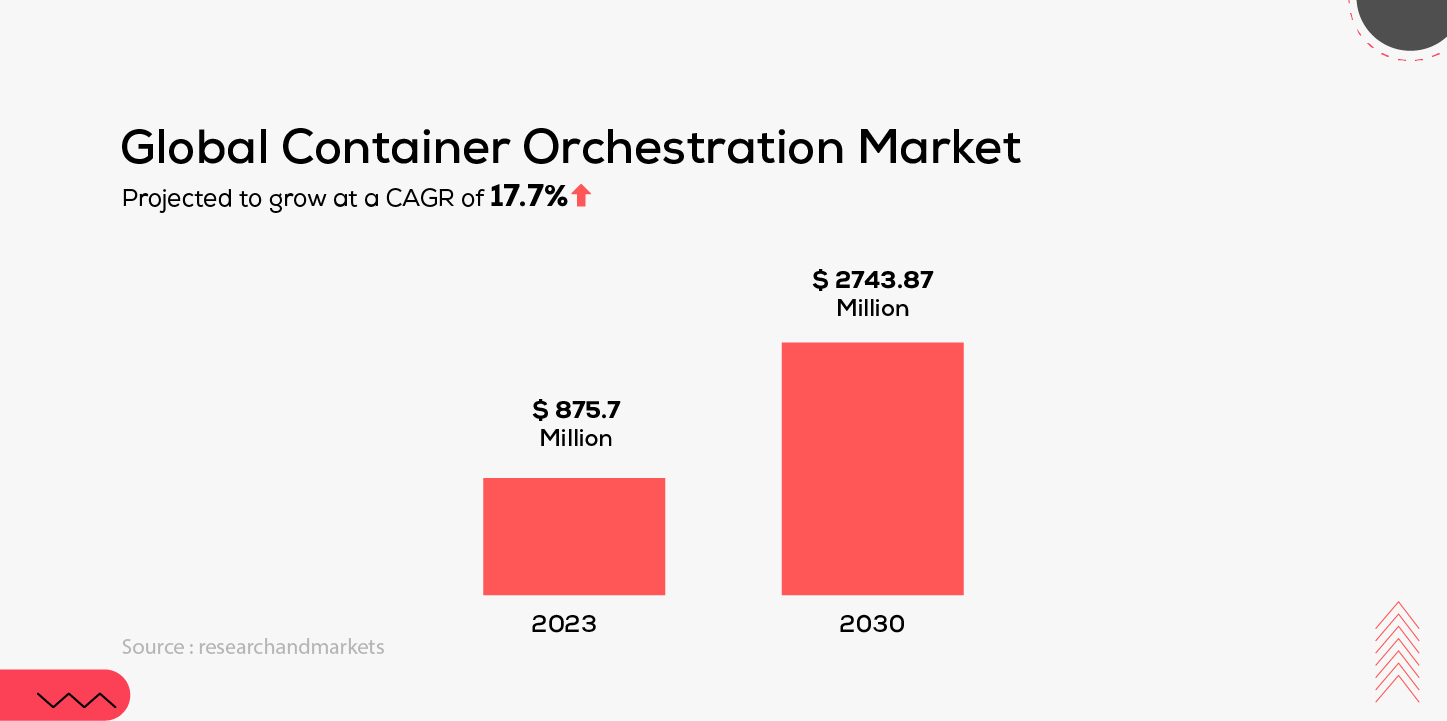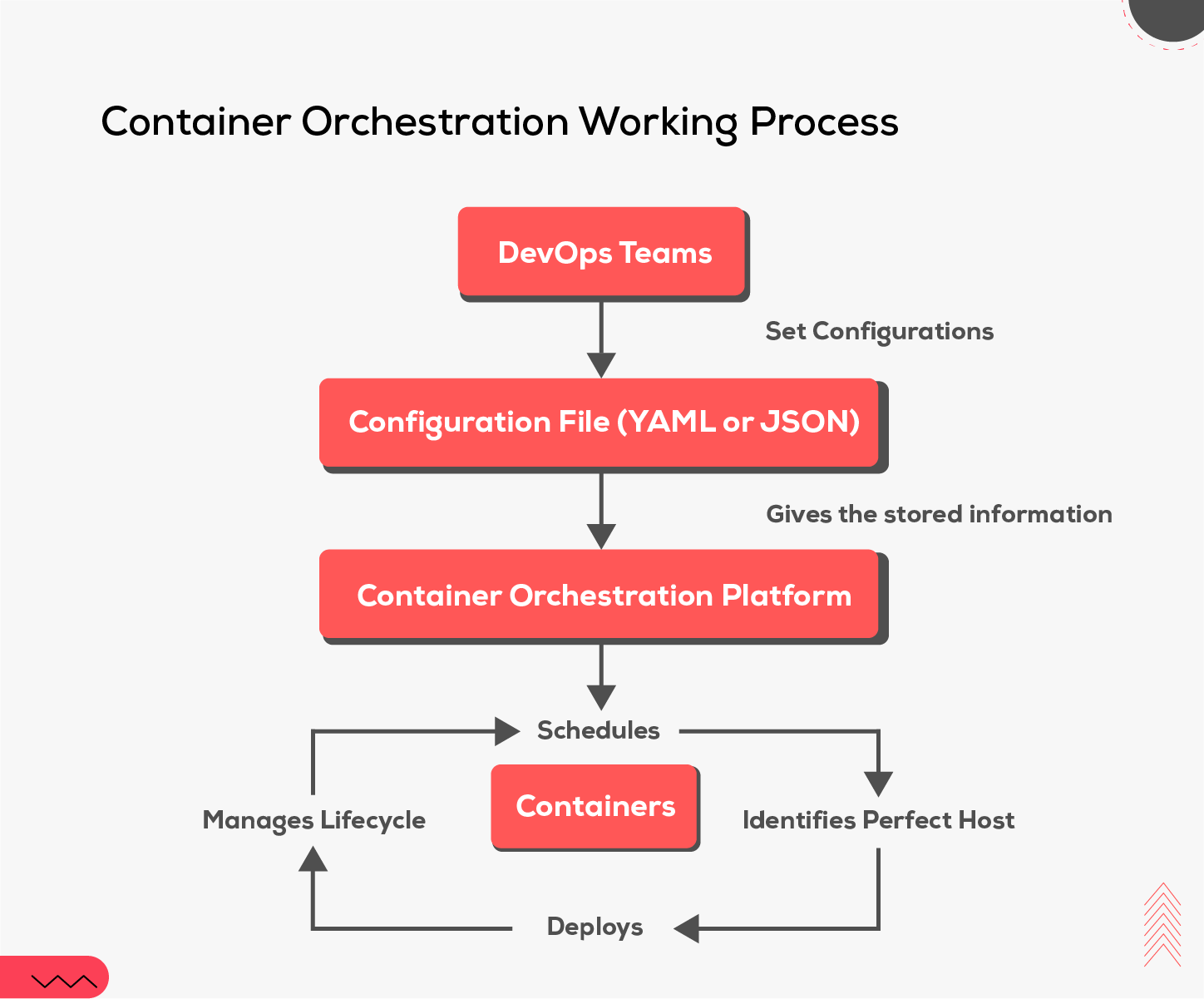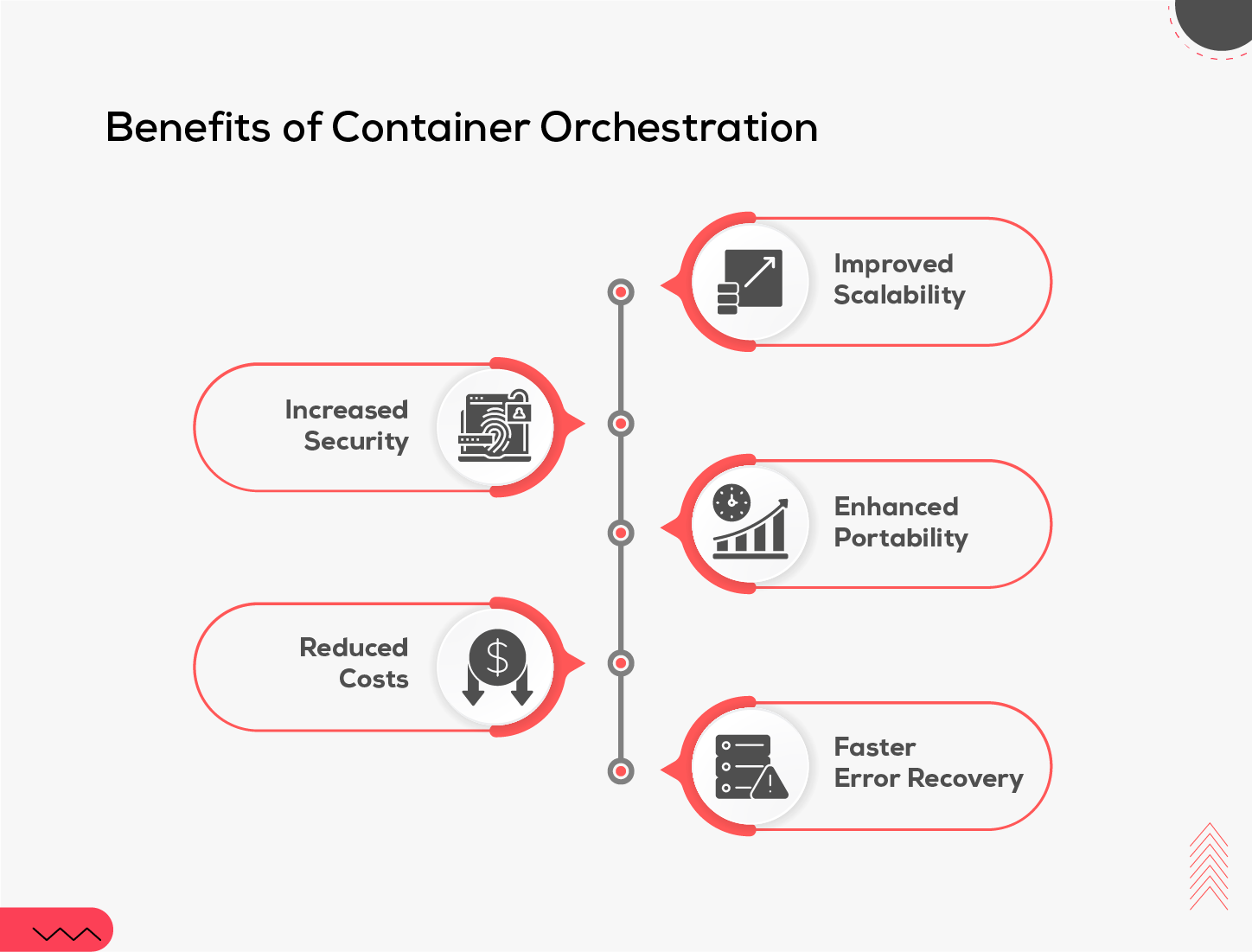Quick Summary: Container orchestration is a critical component in modern software development, enabling efficient management, deployment and scaling of containerized applications. However, the effective orchestration of these containers across complex environments remains a challenge for many organizations. Learn how container orchestration streamlines the deployment process, empowers DevOps teams and drives innovation.
The rapid growth in software demand has significantly impacted the technology sector. Over the years the deployment into production has undergone major changes and the applications have brought the necessity of packing the code in containers like Docker. However, deploying containerized applications in production requires more than building containers with Docker Engine and here is where Container orchestration plays an important role.
This article delves into container orchestration, its working processes, best practices, benefits, challenges and tools for effective implementation.
But before we begin, let’s understand what Container orchestration is.
Understanding Container Orchestration
Container orchestration is a technique of deploying and automating the operational efforts needed to run containerized services and workloads.
Various features are automated in the container life cycle including scaling, deployment, traffic routing and load balancing. The container orchestration streamlines container management and ensures efficiency within the environment.
By automating these tasks, container orchestration platforms streamline container management. They handle the difficulties of spinning containers, suspending them or shutting them down, ensuring efficient operation within distributed environments.
Container orchestrator appears as a keystone of modern cloud computing, empowering automation and efficiency across diverse environments, particularly in multi-cloud and microservices architectures.
Orchestration technologies like Kubernetes have become essential tools for engineering teams, enabling consistent management of containerized applications throughout their entire software development lifecycle, from development and deployment to testing and monitoring.
They provide complete insights into application performance, resource utilization, and potential issues, enabling performance optimiation. This helps ensure the availability and reliability of containerised applications in production environments.
According to a survey conducted by Research and Markets, the global market of container orchestration is expected to grow at a CAGR of 17.7% between 2023 and 2030. The market was valued at USD 875.7 million in 2023 and is expected to reach USD 2,743.87 million by 2030.

Container Orchestration - The Working Process
The most popular container orchestration tools like Google Kubernetes Engine (GKE), managed by Kubernetes service offered by Google Cloud Platforms, have become important for dealing with the difficulties of containerized applications, especially in large-scale deployments that involve several containers and micro-services. They automate tasks such as traffic routing, load balancing, seamless operations, scaling and efficient resource management.
These orchestration tools aim to manage an application, ranging from deployment to monitoring. Even though each tool has separate methodologies, a container orchestration system sticks to three fundamental steps.

Set Configurations
Almost all the container orchestration platforms perform a declarative configuration model. The orchestration typically requires information on the precise location of container images within the system. The DevOps teams can define the blueprint for application configuration and workloads using languages like YAML or JSON files.
These files carry information like storage volumes, logs and container networking, which support the workloads by:
- Providing storage to the containers
- Demonstrating secured network connections between containers
- Outlining the desired configuration state
In container orchestration, the configuration files are stored in branches and are managed using version control. This allows the orchestration tool to consistently apply the same configuration on the target system, ensuring consistent results.
Deploy Containers
The second step is all about deploying the corresponding containers to the host. When a new container is required for cluster deployment, the container orchestration platform achieves the event. Following that, based on the requirements specified in the configuration file, the container orchestration tool determines the suitable host for running the containers. Multiple conditions like the placement of containers based on the availability of memory, metadata and CPU capacity, can be predefined.
Manage the Container Life Cycle
Once the container is running, the orchestration tool will achieve its entire lifespan by following the strategies in the compose file configuration. The steps involved include:
- Distributing application load across infrastructure and managing resource allocation among containers is essential for optimal performance, especially in container-based applications. Load balancing plays an important role in achieving peak performance and traffic management.
- In case of a host failure, containers can be migrated from one host to another, allowing high availability and performance.
- Collecting log data and telemetry to monitor the health and execution of the application.
Best Practices to Optimize Container Orchestration
After the implementation of DevOps, containerization technology and container orchestration are often seen as logical steps by various organizations. Although the containers are delicate and transportable, their usability is not always simple. Implementing containerized workloads can be complex due to various challenges such as security concerns, networking issues, and the utilization of Continuous Integration/Continuous Deployment pipelines for container image generation.
Here are the top 3 best practices to follow when facing challenges during the deployment of containers in a production environment.
1. Establish a Defined Path from “Development to Production”
It is important to understand the steps involved in taking a containerized application from the initial development phase to final production. It is important to use a staging platform when using container orchestration, which is similar to the production environment. This can help to identify the impact.
Further, executing DevOps best practices can strengthen monitoring.
2. Implementing Monitoring Solution
Since development and operations are linked to DevOps practices, it becomes important to have automated reports. These reports enable technical teams to promptly address issues. The containerized platforms get advantages from metrics, logs and traces.
Additionally, the container monitoring tools can be used to collect data on a variety of metrics and identify areas where the management process can be enhanced.
3. Prioritize Backup and Recovery
Until the application runs popular, the containers store data in the same container. However, when the user base grows, it becomes necessary to use external databases, which may or may not be containerized. But it is critical to have secondary copies and independent storage systems.
Though public cloud providers have several measures in place to eliminate the risks, it is important to have data protection and recovery in place. Therefore, having a well-defined, and tested data recovery mechanism is crucial.
Benefits of Container Orchestration
Container orchestration has transformed the landscape of deployment, management and scalability. In today's fast-paced computing environment, container orchestration platforms present numerous advantages. By adopting the benefits of container orchestration, businesses can achieve greater agility, scalability, and reliability in the software delivery pipelines.

1. Improved Scalability
By using container orchestration, the application becomes more scalable and reliable. The number of containers running is limited by the resources available on each machine. Therefore, the application will scale better than without orchestration tools.
2. Increased Security
Container orchestration tools enhance security by letting users manage security policies across several platforms and the visibility is provided across all components.
3. Enhanced Portability
Containers make it easy for developers to deploy their applications to any cloud provider because no code changes are required due to being portable within the environment’s ecosystem. Even without prior experience, containers can be used by anyone who can start them right away.
4. Reduced Costs
Containers are more cost-effective compared to virtual machines as they require fewer resources and have lower overhead costs. Overall, containers can help businesses to reduce costs in several ways like reduced storage costs, networking costs, and management costs.
5. Faster Error Recovery
The biggest advantage of container orchestration is the detection of failures in infrastructure. Finally, containers help maintain high availability and boost the uptime of applications.
Challenges of Container Orchestration
Though container orchestration offers numerous benefits, it does have challenges to overcome. Let’s delve into the challenges of container orchestration.
1. Securing Container Images
Instead of creating images from scratch, users can adopt reusable images to generate containers. However, irrespective of the dependencies, they may have security vulnerabilities. These challenges in container orchestration can be mitigated by security mechanisms into CI/CD pipelines.
2. Picking the Ideal Container Technology
As organizations increasingly adopt containers, the container market is experiencing rapid growth. However, he development teams often find it difficult to choose between the container platforms. One of the effective ways to select the right container technology is through the assessment of tools that meet their business requirements.
3. Managing Ownership
Another challenge of container orchestration is determining the ownership. Here, two teams share the responsibility. Firstly, the development team, where the written code is deployed and the operation team takes responsibility for the deployment. These issues can be resolved through effective DevOps practices.
Best Container Orchestration Tools
Container orchestration tools need a reliable toolchain that can deploy, monitor and configure the application effectively. This toolchain integrates numerous tools that support the entire application life cycle. These tools are used to automate various tasks including:
- Health Monitoring
- Container deployment and provisioning
- Load balancing and traffic routing
- Container Scheduling
- Container upgrades
Below is a list of top container orchestration Tools:
1. Kubernetes
Widely known as the popular tool in this space, Kubernetes was outlined by Google and is now led by the Cloud Native Computing Foundation (CNCF). Being an open-source tool, Kubernetes offers numerous advantages including automated load balancing, auto-scaling, and flexibility. It contains four main components called the node, cluster, labels and replication controllers.
2. OpenShift
Originally developed by Red Hat, OpenShift is a robust tool that is built upon Kubernetes, offering GitOps functionality and Platform-as-a-service (PaaS) capabilities. Additionally, it can be incorporated with various delivery tools, like Jenkins CI/CD pipelines. OpenShift excels in managing tasks involving performance tracking, policy control and security features.
3. Docker Swarm
This widely known tool is built into Docker and serves as a replacement for Kubernetes. It supports rolling updates, service discovery and declarative scaling. Docker Swarm offers numerous advantages like high service availability, increased scalability, lightweight and portability.
4. Mirantis Kubernetes Engine
Earlier known as Docker Enterprise Edition, Mirantis Kubernetes Engine is a versatile tool that supports both Docker Swarm and Kubernetes cluster, providing ultimate flexibility. It combines the Mirantis platform to have regular updates of open-source software. The key advantages of Mirantis Kubernetes Engine involve continuous integration for faster deployment, easier management and portability.
5. Amazon Elastic Container Service (Amazon ECS)
Organizations find it easy to deploy and run containers with the help of Amazon ECS. It can integrate with Amazon Fargate, a serverless computing engine, allowing developers to define resource requirements. Instead of managing infrastructure, the focus lies on streamlining applications. The added features of Amazon ECS include optimized cost and compatibility with various environments.
Closing Thoughts
Organizations use container orchestration to regulate large-scale applications and is an integral part of software development. The orchestration tools help to provide better customer satisfaction, thereby reducing the complexities of containerized applications. With the availability of popular orchestration tools in the market, organizations gain a variety of options for managing containerized applications and can select the best platforms for their needs.
In conclusion, by following the best practices and tools, organizations can stimulate the software development lifecycle and optimize the resources.
Frequently Asked Questions
1. Name some of the popular container orchestration platforms.
Some of the popular container orchestration platforms include– Rancher, Nomad, and Apache Mesos.
2. What are the security considerations to keep in mind while working with container orchestration?
While containerization shares some security concerns, it also offers opportunities to enhance security if implemented correctly. Due to its lightweight and user-friendly nature, containers can readily be deployed.
3. What is the difference between containers and virtual machines (VM)?
Though containers and virtual machines have numerous similarities, they both are different. Containers share the same lightweight host OS, typically just megabytes in size. Whereas, virtual machines have their guest operating systems, each having its own complete OS.
4. Give two use cases of containers
Organizations use containers in several ways. The common 2 use cases of containers include: Some containers are utilized for purposes to migrate the application to modern environments. This offers the benefits of operating system virtualization. Secondly, though is more demanding than lift and shift migration, it unlocks the full potential of containerization.
5. What are the advantages of Kubernetes?
Kubernetes being the most popular tool covers various advantages including - Service discovery, container deployment, storage provisioning and self-healing for high availability.







